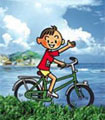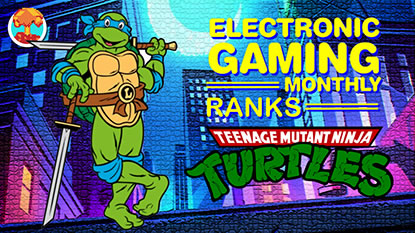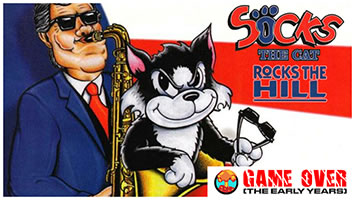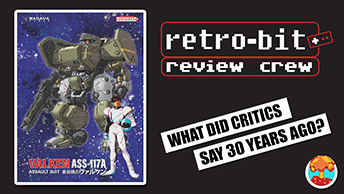- CLASSIC MAGAZINES
- REVIEW CREW
A show recapping what critics thought back
when classic games first came out! - NEXT GENERATION'S BEST & WORST
From the worst 1-star reviews to the best
5-stars can offer, this is Next Generation! - NINTENDO POWER (ARCHIVE)
Experience a variety of shows looking at the
often baffling history of Nintendo Power! - MAGAZINE RETROSPECTIVE
We're looking at the absolutely true history of
some of the most iconic game magazines ever! - SUPER PLAY'S TOP 600
The longest and most ambitious Super NES
countdown on the internet! - THEY SAID WHAT?
Debunking predictions and gossip found
in classic video game magazines! - NEXT GENERATION UNCOVERED
Cyril is back in this spin-off series, featuring the
cover critic review the art of Next Generation! - HARDCORE GAMER MAGAZING (PDF ISSUES)
Download all 36 issues of Hardcore Gamer
Magazine and relive the fun in PDF form!
- REVIEW CREW
- ELECTRONIC GAMING MONTHLY
- ELECTRONIC GAMING MONTHLY RANKS
From Mario to Sonic to Street Fighter, EGM
ranks classic game franchises and consoles! - ELECTRONIC GAMING MONTHLY BEST & WORST
Counting down EGM’s best and worst reviews
going year by year, from 1989 – 2009! - ELECTRONIC GAMING BEST & WORST AWARDS
11-part video series chronicling the ups and
downs of EGM’s Best & Worst Awards!
- ELECTRONIC GAMING MONTHLY RANKS
- GAME HISTORY
- GAME OVER: STORY BREAKDOWNS
Long-running series breaking down game
stories and analyzing their endings! - A BRIEF HISTORY OF GAMING w/ [NAME HERE]
Real history presented in a fun and pithy
format from a variety of game historians! - THE BLACK SHEEP
A series looking back at the black sheep
entries in popular game franchises! - INSTANT EXPERT
Everything you could possibly want to know
about a wide variety of gaming topics! - FREEZE FRAME
When something familiar happens in the games
industry, we're there to take a picture! - I'VE GOT YOUR NUMBER
Learn real video game history through a series
of number-themed episodes, starting at zero! - GREAT MOMENTS IN BAD ACTING
A joyous celebration of some of gaming's
absolute worst voice acting!
- GAME OVER: STORY BREAKDOWNS
- POPULAR SHOWS
- DG NEWS w/ LORNE RISELEY
Newsman Lorne Riseley hosts a regular
series looking at the hottest gaming news! - REVIEW REWIND
Cyril replays a game he reviewed 10+ years
ago to see if he got it right or wrong! - ON-RUNNING FEUDS
Defunct Games' longest-running show, with
editorials, observations and other fun oddities! - DEFUNCT GAMES QUIZ (ARCHIVE)
From online quizzes to game shows, we're
putting your video game knowledge to the test!- QUIZ: ONLINE PASS
Take a weekly quiz to see how well you know
the news and current gaming events! - QUIZ: KNOW THE GAME
One-on-one quiz show where contestants
find out if they actually know classic games! - QUIZ: THE LEADERBOARD
Can you guess the game based on the classic
review? Find out with The Leaderboard!
- QUIZ: ONLINE PASS
- DEFUNCT GAMES VS.
Cyril and the Defunct Games staff isn't afraid
to choose their favorite games and more! - CYRIL READS WORLDS OF POWER
Defunct Games recreates classic game
novelizations through the audio book format!
- DG NEWS w/ LORNE RISELEY
- COMEDY
- GAME EXPECTANCY
How long will your favorite hero live? We crunch
the numbers in this series about dying! - VIDEO GAME ADVICE
Famous game characters answer real personal
advice questions with a humorous slant! - FAKE GAMES: GUERILLA SCRAPBOOK
A long-running series about fake games and
the people who love them (covers included)! - WORST GAME EVER
A contest that attempts to create the worst
video game ever made, complete with covers! - LEVEL 1 STORIES
Literature based on the first stages of some
of your favorite classic video games! - THE COVER CRITIC
One of Defunct Games' earliest shows, Cover
Critic digs up some of the worst box art ever! - COMMERCIAL BREAK
Take a trip through some of the best and
worst video game advertisements of all time! - COMIC BOOK MODS
You've never seen comics like this before.
A curious mix of rewritten video game comics!
- GAME EXPECTANCY
- SERIES ARCHIVE
- NINTENDO SWITCH ONLINE ARCHIVE
A regularly-updated list of every Nintendo
Switch Online release, plus links to review! - PLAYSTATION PLUS CLASSIC ARCHIVE
A comprehensive list of every PlayStation
Plus classic release, including links! - RETRO-BIT PUBLISHING ARCHIVE
A regularly-updated list of every Retro-Bit
game released! - REVIEW MARATHONS w/ ADAM WALLACE
Join critic Adam Wallace as he takes us on a
classic review marathon with different themes!- DEFUNCT GAMES GOLF CLUB
Adam Wallace takes to the links to slice his way
through 72 classic golf game reviews! - 007 IN PIXELS
Adam Wallace takes on the world's greatest spy
as he reviews 15 weeks of James Bond games! - A SALUTE TO VAMPIRES
Adam Wallace is sinking his teeth into a series
covering Castlevania, BloodRayne and more! - CAPCOM'S CURSE
Adam Wallace is celebrating 13 days of Halloween
with a line-up of Capcom's scariest games! - THE FALL OF SUPERMAN
Adam Wallace is a man of steel for playing
some of the absolute worst Superman games! - THE 31 GAMES OF HALLOWEEN
Adam Wallace spends every day of October afraid
as he reviews some of the scariest games ever! - 12 WEEKS OF STAR TREK
Adam Wallace boldly goes where no critic has
gone before in this Star Trek marathon!
- DEFUNCT GAMES GOLF CLUB
- DAYS OF CHRISTMAS (ARCHIVE)
Annual holiday series with themed-episodes
that date all the way back to 2001!- 2015: 30 Ridiculous Retro Rumors
- 2014: 29 Magazines of Christmas
- 2013: 29 Questionable Power-Ups of Christmas
- 2012: 34 Theme Songs of Christmas
- 2011: 32 Game Endings of Christmas
- 2010: 31 Bonus Levels of Christmas
- 2009: 30 Genres of Christmas
- 2008: 29 Controls of Christmas
- 2007: 34 Cliches of Christmas
- 2006: 33 Consoles of Christmas
- 2005: 32 Articles of Christmas
- 2004: 31 Websites of Christmas
- 2003: 29 Issues of Christmas
- 2002: 28 Years of Christmas
- 2001: 33 Days of Christmas
- NINTENDO SWITCH ONLINE ARCHIVE
- REVIEW ARCHIVE
- FULL ARCHIVE
Sony PlayStation (1995)
It's time once again for Defunct Games' 33 Consoles of Christmas, your 33 part guide to the best and worst system designs of all time. Join Cyril Lachel and Chad Reinhardt as they judge 33 different game consoles based on what they think of the look. Forget about actual hardware and software, the only thing these guys care about is talking about their exterior design. Join us every day between November 23 and December 25 for a new console review!

Synopsis: When video game historians look back at the game consoles that changed everything two different systems spring to mind. The first system you think of is probably the Nintendo Entertainment System, the console that managed to revitalize the entire industry after a great game crash. Ten years later we would see another important system, the one console that managed to break down the idea that games were for kids and that it could never be a mass market product. Sony's 32-bit console was the first console to really connect with adults in a major way; with its wide variety of games and emphasis on 3D graphics, the PlayStation had something for just about everybody. And it wasn't just about the hardware, the PlayStation managed to make role-playing games cool in the United States and the software was cheap enough that a lot of smaller companies were willing to bring over games we would have otherwise never seen. With its huge list of amazing games, the PlayStation is still considered one of the greatest consoles of all time.
Best Games: Final Fantasy VII, Tekken 3, Gran Turismo 2, Bushido Blade, Jumping Flash, Metal Gear Solid, Final Fantasy VII, Parappa the Rapper, Tobal 2, Castlevania: Symphony of the Night, Tony Hawk's Pro Skater 2, Final Fantasy Tactics, X-Com, Resident Evil, Chrono Cross, and many, many more!




Synopsis: When video game historians look back at the game consoles that changed everything two different systems spring to mind. The first system you think of is probably the Nintendo Entertainment System, the console that managed to revitalize the entire industry after a great game crash. Ten years later we would see another important system, the one console that managed to break down the idea that games were for kids and that it could never be a mass market product. Sony's 32-bit console was the first console to really connect with adults in a major way; with its wide variety of games and emphasis on 3D graphics, the PlayStation had something for just about everybody. And it wasn't just about the hardware, the PlayStation managed to make role-playing games cool in the United States and the software was cheap enough that a lot of smaller companies were willing to bring over games we would have otherwise never seen. With its huge list of amazing games, the PlayStation is still considered one of the greatest consoles of all time.
Best Games: Final Fantasy VII, Tekken 3, Gran Turismo 2, Bushido Blade, Jumping Flash, Metal Gear Solid, Final Fantasy VII, Parappa the Rapper, Tobal 2, Castlevania: Symphony of the Night, Tony Hawk's Pro Skater 2, Final Fantasy Tactics, X-Com, Resident Evil, Chrono Cross, and many, many more!



I can already hear it now: "Cyril, if you hated the look of the Sega Saturn then how could you possibly like the Sony PlayStation?" Well, my imaginary friend, it's all because of the size of the CD tray. When you open the PlayStation you really know you have it open, almost the entire top of the system opens up to say "ahh." You may remember me saying that the Saturn's CD flap makes the system look larger; well the same is true with the PlayStation ... but only in reverse. Once you've put a game into Sony's 32-bit system you can't help but think the system is smaller than it actually is. Along with the CD trap, I also like the placement of the two memory card slots. There's just something about Sony's small memory cards that I prefer to Sega's enormous memory cartridge. And then there's the shape of the system, the thing is very distinct, when you see a PlayStation you know exactly what you're looking at. I like the large circle on the front, I like the two cuts going down the system, I even like the pokey edges on each side of the console. It's also worth mentioning that the PlayStation was one of the first console that didn't look like a "toy". When you first saw the system you knew it wasn't meant for young kids, it felt like the system was aimed at an older demographic. Sadly I can't say the same thing about the Saturn or Nintendo 64, and perhaps that's why the PlayStation is the system that is credited for ushering in a new generation of gamers. It's certainly not the best looking console on the market, but it's unique and easy on the eyes.
Sony was as scrappy a newcomer as was possible, with their ultra-aggressive "You Are Not Ready" slogan and dark, edgy commercials. I was originally very put off by the whole production; the fact that this new kid so boldly stepped up to challenge Sega and Nintendo made me kind of mad. The system itself isn't very visually appealing to me. The fact that many of the first systems had to be propped up on their sides ushered in a now common trend of first gen systems not working properly. Aside from the fan, there was little to worry about as far as malfunction was concerned, and it does look a great deal different than the other two consoles. The buttons on the front of the console fit nicely, but the light grey color made it seem less intimidating and a little more sterile than the boisterous commercials. I liked the smaller, later incarnation more, but the classic design was acceptable.
HOME |
CONTACT |
NOW HIRING |
WHAT IS DEFUNCT GAMES? |
NINTENDO SWITCH ONLINE |
RETRO-BIT PUBLISHING
Retro-Bit |
Switch Planet |
The Halcyon Show |
Same Name, Different Game |
Dragnix |
Press the Buttons
Game Zone Online | Hardcore Gamer | The Dreamcast Junkyard | Video Game Blogger
Dr Strife | Games For Lunch | Mondo Cool Cast | Boxed Pixels | Sega CD Universe | Gaming Trend
Game Zone Online | Hardcore Gamer | The Dreamcast Junkyard | Video Game Blogger
Dr Strife | Games For Lunch | Mondo Cool Cast | Boxed Pixels | Sega CD Universe | Gaming Trend
Copyright © 2001-2025 Defunct Games
All rights reserved. All trademarks are properties of their respective owners.
All rights reserved. All trademarks are properties of their respective owners.




























